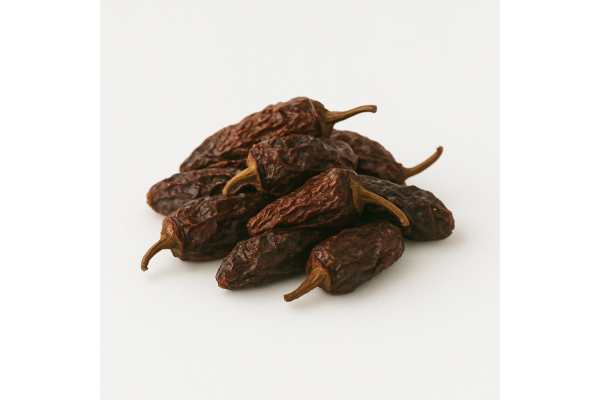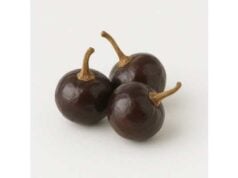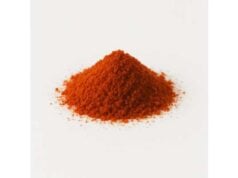
Chipotle peppers have become a signature flavor in modern cooking, but many people are not entirely sure what they are or how they differ from other chilies. At its simplest, chipotle is a ripe red jalapeño that has been slowly smoke-dried, transforming a fresh, grassy pepper into something deep, smoky, and complex. That process concentrates heat and flavor, and it also changes the nutritional and phytochemical profile compared with the fresh chili.
Because chipotle shows up in powders, canned sauces, spice blends, and restaurant dishes, it is easy to underestimate how much you are eating or how it might affect your health. Capsaicin and other compounds in chipotle have been studied for potential benefits for metabolism, appetite regulation, and cardiovascular markers, but very spicy diets and smoked foods also raise questions about digestive comfort and long-term safety. This guide explains what chipotle is, how it fits into a healthy pattern of eating, how to use it in your kitchen, and when caution makes sense.
Chipotle at a Glance
- One teaspoon (about 2.5 g) of chipotle powder usually supplies fewer than 10 calories but noticeable flavor and a small boost of fiber.
- Capsaicin and antioxidant compounds in chipotle may modestly support metabolic and cardiovascular health when the spice is used in culinary amounts.
- A practical serving for most adults is about 1/4–1/2 teaspoon of chipotle powder per portion, up to several times per week, adjusted to heat tolerance.
- People with reflux, ulcers, irritable bowel syndrome, inflammatory bowel disease, or chili allergy should limit or avoid chipotle and discuss spicy foods with a clinician.
- Very high intakes of chilies and frequent use of smoked products may irritate the digestive tract and add to exposure to smoke-related contaminants, so moderation is sensible.
Table of Contents
- Chipotle Pepper Detailed Overview
- Chipotle Nutrition Profile and Key Compounds
- Evidence-Based Health Benefits of Chipotle
- Chipotle Risks, Allergies and Interactions
- Selecting Quality Chipotle and Storing It Safely
- Chipotle Preparation, Cooking and Nutrient Retention
- Chipotle Portions, Comparisons and FAQs
Chipotle Pepper Detailed Overview
Chipotle is not a separate botanical species, but a form of jalapeño at a particular stage of maturity and preservation. Farmers allow jalapeños to stay on the plant until they turn red, indicating full ripeness. These ripe peppers naturally have lower water content, slightly sweeter flavor, and a richer aroma. They are then smoke-dried for many hours, traditionally over hardwoods such as pecan or oak, until the flesh becomes leathery and the flavor concentrated.
Two traditional types of chipotle are often described. Chipotle morita is smaller, dark red to purple-brown, and typically smoked for less time. It has a fruity, tangy edge and medium smokiness. Chipotle meco, sometimes called típico or ahumado, is larger and tanned to a grayish brown, with intense smokiness and a drier texture. Both are made from red jalapeños, but morita is more common in packaged products, whereas meco is prized for certain sauces and stews.
In terms of heat, chipotle usually falls into the same general range as jalapeño, roughly in the low thousands on the Scoville scale. Many people perceive chipotle as slightly hotter because the drying process reduces water content and concentrates capsaicin. At the same time, the smoke and sweetness tend to round off the sharpness, giving a gentler, slow-building burn rather than a sharp sting.
Culinarily, chipotle occupies a unique niche. It brings both chili heat and a barbecue-like smokiness in one ingredient, which is why it shows up in salsas, marinades, dry rubs, braises, and creamy sauces. In Mexican and Mexican-inspired cooking, whole dried chipotles are rehydrated and blended into sauces such as adobo and certain moles. Chipotle in adobo, sold in small cans, combines rehydrated chipotles with a tangy tomato, vinegar, and spice sauce that many home cooks use as a shortcut.
It is helpful to distinguish between the chipotle pepper as a spice and branded dishes or restaurant chains that happen to use the name. This article focuses on the pepper itself, whatever form it takes in your pantry, and how to use it to support flavor and health.
Chipotle Nutrition Profile and Key Compounds
Chipotle is used in small amounts, so its nutritional impact comes less from macronutrients and more from its concentration of fiber, antioxidants, and bioactive compounds like capsaicin. On a dry-weight basis, chipotle is relatively energy-dense, but a typical serving is modest.
If you look at rough estimates per 100 grams of dried chipotle, you will see a few hundred calories, mostly from carbohydrates, along with notable fiber and a decent amount of protein. However, home cooks rarely come close to that amount. A teaspoon of chipotle powder might weigh around 2.5 grams and contain fewer than 10 calories, less than 1 gram of fiber, and trace amounts of protein and fat. A tablespoon might have closer to 20–25 calories and around 2 grams of fiber.
Chipotle contains a range of vitamins and minerals, although many are present in small quantities at practical serving sizes. Dried chipotle can provide:
- Provitamin A carotenoids supporting vision and immune function
- Vitamin C, though reduced from fresh jalapeños by drying and smoking
- Vitamin K and several B vitamins, including vitamin B6 and niacin
- Minerals such as potassium, magnesium, iron, and manganese
From a single teaspoon, the contribution to daily requirements is small, but if you use chipotle regularly across meals, these contributions accumulate alongside other nutrient-dense foods.
What makes chipotle particularly interesting nutritionally are its bioactive compounds. The most prominent are the capsaicinoids, a family of molecules that include capsaicin. They activate specific receptors involved in sensing heat and pain, producing the familiar burning sensation. This interaction has downstream effects on metabolic rate, appetite regulation, and possibly vascular function.
Chipotle also contains carotenoids such as beta-carotene and various phenolic compounds. These contribute to antioxidant capacity, helping neutralize reactive oxygen species that would otherwise damage cells and tissues. Some research suggests that the smoking process may increase total phenolic content, although it can reduce vitamin C and alter the balance of other compounds.
The simplest chipotle products—whole dried peppers or pure powder—contain only these naturally occurring nutrients and plant chemicals, with minimal sodium and sugar. Chipotles in adobo and many commercial chipotle sauces, however, can include added salt, sugar, oils, and preservatives. Checking labels is important if you are watching sodium or added sugars. For people seeking the health advantages of chipotle without extra sodium, plain dried peppers or unsalted powder are usually better choices.
Overall, chipotle behaves nutritionally as a low-calorie, low-sodium, high-flavor ingredient whose main value lies in its ability to make otherwise simple, healthy foods more enjoyable.
Evidence-Based Health Benefits of Chipotle
Most scientific research examines chili peppers or capsaicin in general, not chipotle alone, but the same group of compounds is responsible for many of the potential benefits. When chipotle is used in culinary amounts within a balanced diet, several areas of health are worth considering.
One widely discussed area is weight management. Controlled trials of capsaicin supplementation show modest but measurable effects on body weight and body composition in people with overweight or obesity. Capsaicin appears to slightly increase energy expenditure and fat oxidation, and it may help some individuals feel more satisfied after meals, leading to lower spontaneous calorie intake. These effects are not large enough to replace lifestyle measures, but they suggest that a diet including capsaicin-rich spices like chipotle could offer small advantages when combined with mindful eating and regular activity.
Cardiovascular health is another area of interest. Observational studies where people report their usual intake of spicy foods and are followed for years generally find that regular chili consumers have lower risks of death from cardiovascular causes and sometimes from all causes combined. While these studies cannot prove cause and effect, they align with controlled trials showing that capsaicin and related compounds can improve some markers related to metabolic syndrome, such as blood lipid levels, blood pressure, or waist circumference, in certain groups.
Blood sugar regulation may also benefit. Experimental work suggests that capsaicin can influence insulin sensitivity and the way the body handles glucose after a meal. These effects appear to be modest and vary between individuals, but they support the idea that chili-containing diets, including moderate chipotle use, can fit well within plans aimed at maintaining blood sugar control.
Chipotle’s antioxidant and anti-inflammatory potential is tied to its carotenoids and phenolics as well as capsaicin. These compounds may help reduce oxidative stress and modulate inflammatory pathways in the body. Some of the benefits attributed to chili-rich diets, such as better vascular function or more favorable lipid profiles, may partly reflect these mechanisms.
It is important to emphasize that chipotle is not a cure or primary treatment for any condition. Instead, it can be part of a pattern that emphasizes vegetables, legumes, whole grains, lean proteins, and healthy fats. Within that context, chipotle and similar spices can play a supportive role by making nutrient-dense meals more satisfying, potentially helping people stick with healthful habits over time.
Finally, there is a quality-of-life aspect. For many, spicy foods enhance enjoyment of meals and cultural food traditions. Pleasure and satisfaction from food are legitimate contributors to sustainable eating patterns, and chipotle offers a way to add depth and complexity to dishes without depending on heavy cream, large amounts of cheese, or sugary sauces.
Chipotle Risks, Allergies and Interactions
While chipotle is safe for most healthy adults when used as a seasoning, there are important situations where caution is appropriate. The same capsaicin that may aid metabolism can also irritate sensitive tissues, and the smoking process introduces additional points to consider.
Digestive discomfort is the most common issue. Spicy foods can trigger or worsen heartburn, chest discomfort, and regurgitation in people with reflux disease. They can also provoke burning pain in the upper abdomen or cause loose stools and urgency in sensitive individuals. Conditions such as gastritis, peptic ulcers, irritable bowel syndrome, and inflammatory bowel disease often become more symptomatic when辣 foods are consumed, especially in large amounts. For these individuals, even small amounts of chipotle may need to be avoided or carefully tested under professional guidance.
Another concern relates to cancer risk. Epidemiological studies in certain regions have linked very high chili consumption with increased risk of specific gastrointestinal cancers, particularly esophageal and sometimes gastric cancers. It is not clear whether capsaicin itself, accompanying irritants, preparation methods, or other lifestyle factors are responsible, and some populations with high chili intake do not show the same associations. Nonetheless, these findings support a cautious approach to extremely heavy use of hot peppers, including chipotle.
Because chipotle is smoked, the potential presence of smoke-related contaminants, especially polycyclic aromatic hydrocarbons, is worth mentioning. Levels vary widely with the type of wood, smoking temperature, and duration. Regulatory bodies set maximum limits for these compounds in foods, and reputable producers design their processes to stay well below those thresholds. Even so, from a precautionary standpoint, it makes sense not to rely heavily on smoked foods of any type and to vary your sources of spice and flavor.
Allergic reactions to Capsicum species are relatively rare but do occur. Symptoms may include itching in the mouth, swelling of the lips or tongue, hives, or, in severe cases, difficulty breathing. Some people also develop contact dermatitis from handling chilies. Anyone who has experienced possible allergic reactions to peppers should avoid chipotle until properly evaluated. Gloves and eye protection are sensible when handling large amounts of whole chipotle peppers in the kitchen.
Certain medications and medical conditions warrant additional care. Capsaicin can influence pain perception and, at high doses, may slightly affect platelet function. People taking anticoagulants, antiplatelet drugs, or medications that irritate the stomach lining should not dramatically increase their intake of very spicy foods without discussing it with their healthcare provider. Pregnant and breastfeeding individuals often find spicy foods uncomfortable due to reflux or nausea, and formal data on very high capsaicin intakes during pregnancy are limited, so moderate culinary use is generally recommended over supplements or extreme diets.
Children are a special case. Their taste preferences and tolerance for heat vary widely, and strong spiciness can discourage them from eating enough. When introducing chipotle to older children, start with tiny amounts in shared family dishes, and prioritize their comfort and willingness to eat a balanced meal over any theoretical benefits.
In short, for most adults, small culinary amounts of chipotle are unlikely to pose major risks, but moderation, attention to individual tolerance, and respect for underlying medical conditions are essential.
Selecting Quality Chipotle and Storing It Safely
The quality and safety of chipotle in your kitchen depend heavily on how it is produced, stored, and used. Paying attention to appearance, aroma, ingredient lists, and storage conditions helps you get the best flavor while minimizing unnecessary risks.
When buying whole dried chipotle peppers, look for pods that are mostly intact, with a rich reddish-brown or tan color depending on the type. They should feel slightly flexible rather than brittle and should smell distinctly smoky and pleasantly sweet. Avoid peppers that look excessively dusty, faded, moldy, or infested with insects. A sour, musty, or rancid smell is a signal to skip that batch.
For chipotle powder, choose products labeled as pure chipotle or smoked jalapeño without added salt, sugar, artificial smoke flavor, or unnecessary fillers if you want precise control over seasoning. The powder should be a deep reddish-brown, not pale or gray. If you prefer blends, read the label for total sodium per serving; some “chipotle seasoning” mixes are essentially flavored salt, which can quickly push you above recommended sodium levels if used liberally.
Canned chipotles in adobo are convenient but can vary dramatically between brands. A straightforward ingredient list typically includes chipotle peppers, tomato, vinegar, garlic, and spices. Some products add substantial amounts of sugar, oils, or thickening agents. Comparing nutrition panels can help you choose versions with moderate sodium and fewer additives.
Sustainability and sourcing are harder to evaluate but still matter. Chipotle production is rooted in Mexican agricultural traditions, and some producers work directly with smallholder farmers who cultivate jalapeños and manage traditional smokehouses. Certifications such as organic labels may indicate lower pesticide use, though they do not guarantee anything about smoke contaminants. If a brand voluntarily shares information about their supply chain, testing for contaminants, and adherence to safety standards, that transparency is a positive sign.
Proper storage prolongs chipotle’s shelf life and preserves flavor. Whole dried peppers and powder should be kept in airtight containers, away from light, heat, and humidity. A cool pantry or cupboard is usually adequate. Storing them near the stove or dishwasher, where temperature and moisture fluctuate, can degrade flavor and encourage spoilage. Under good conditions, whole dried chipotles often retain good quality for one to three years, and powders for one to two years, although aroma begins to fade earlier.
Opened cans of chipotles in adobo should be transferred to a clean, covered container and kept in the refrigerator. They usually maintain quality for a week or two. Freezing leftover chipotles in small portions, such as in an ice cube tray, makes it easy to add a cube or two directly to sauces and stews later without waste.
Regularly check your chipotle stash. If you notice off smells, visible mold, clumping from moisture, or a complete loss of aroma, it is time to discard and replace. Fresh, well-kept chipotle not only tastes better but also reduces the temptation to add large quantities in search of flavor that is no longer there.
Chipotle Preparation, Cooking and Nutrient Retention
Chipotle’s strength lies in how a little can transform a dish. The way you handle, cook, and combine it influences not only flavor and heat but also the retention of beneficial compounds and your overall experience.
Working with whole dried chipotle peppers takes a few steps but rewards you with nuanced flavor. Start by wiping each pepper with a dry cloth to remove any surface dust. Some cooks like to toast the peppers briefly in a dry skillet over low heat for a few seconds per side, just until fragrant; overheating will quickly turn them bitter. After toasting, soak the peppers in hot water or broth for 15 to 30 minutes until they soften. You can then remove stems and most seeds, chop the flesh, or blend it with some of the soaking liquid and aromatics to form a smooth paste or sauce.
Chipotle powder is far more convenient and still very flavorful. Because it is quite potent, a common starting point is about 1/4 teaspoon per serving in cooked dishes, adjusting up or down according to taste. Stirring the powder into oil or another fat at the beginning of cooking can help release fat-soluble flavor compounds, but be careful not to burn it. Alternatively, you can add chipotle powder later in cooking to preserve more of its aroma and any remaining heat-sensitive nutrients.
From a nutrient perspective, many of chipotle’s valuable compounds are relatively stable. Capsaicin tolerates heat well, and dried herbs and spices often retain much of their antioxidant capacity during normal cooking. Some vitamins, especially vitamin C, do degrade with prolonged heat and exposure to air, but chipotle is not your primary vitamin C source to begin with. You can build vitamin C into dishes by pairing chipotle with tomatoes, bell peppers, citrus, or fresh herbs.
If you or someone you cook for is sensitive to heat, there are ways to enjoy chipotle’s smokiness without overwhelming burn. One approach is to cook a whole chipotle pepper in a pot of soup or stew and remove it before serving, leaving behind gentle background flavor. Another is to blend a small quantity of chipotle with sweeter vegetables such as roasted carrots, sweet potatoes, or squash to create sauces and spreads where natural sweetness softens the spice. Combining chipotle with non-spicy smoked paprika is another strategy to stretch smoky notes while diluting capsaicin.
Chipotle pairs especially well with beans, lentils, and whole grains, where its intensity balances mild, earthy flavors. It works in marinades for tofu, fish, poultry, or lean meats and in dressings and dips based on yogurt, avocado, or tahini. In each case, acids like lime juice or vinegar and a bit of fat help round out flavors and create a more complex taste experience, which can make fiber-rich plant foods more appealing.
Because chipotle is concentrated, it is easy to overshoot your ideal heat level. Adding a bit of dairy (such as yogurt or a mild cheese), extra vegetables, a starchy side, or a squeeze of citrus can help calm a dish that turned out too spicy. Keeping these adjustments in mind makes it safer to experiment and refine your preferred intensity.
Chipotle Portions, Comparisons and FAQs
Knowing how much chipotle to use, how it compares to other spicy ingredients, and how to adapt it to different situations helps you enjoy it more confidently and comfortably.
There is no official recommended daily intake for chipotle, but insights from chili and capsaicin research give some context. In many controlled studies, capsaicin doses roughly equivalent to a few grams of chili powder per day have been used without major safety concerns in healthy adults. Translating that into kitchen terms, reasonable culinary use for most adults might look like 1/4 to 1/2 teaspoon of chipotle powder per serving of food, appearing in several meals per week rather than at every meal in large quantities.
Heat tolerance varies widely. People who regularly eat spicy food may comfortably handle more, while others find even small amounts uncomfortable. A simple rule is to start low, especially if you are not accustomed to chilies, and increase slowly while monitoring how your digestive system and overall comfort respond. For individuals with diagnosed digestive diseases or a history of gastrointestinal cancer, any increase in spicy food intake should be discussed with a clinician.
Comparing chipotle to other chili options can guide substitutions. Fresh jalapeños have a similar nominal heat range but a brighter, greener flavor and much higher water content. They supply more vitamin C per gram but lack the smokiness of chipotle. Cayenne pepper is usually significantly hotter and offers straightforward heat with minimal smoke, so you need less cayenne than chipotle for the same level of burn. Generic chili powder blends often mix milder chilies with cumin, oregano, garlic, and sometimes salt; chipotle powder is usually just the smoked chili, giving you more precise control over both flavor and sodium.
Chipotle also differs from bottled hot sauces. Many hot sauces are built on vinegar and can be quite high in sodium. When you season food mainly with chipotle powder or whole peppers and then add salt separately, you have more flexibility to keep sodium in check while still achieving robust flavor. Chipotle in adobo, on the other hand, can be relatively salty and tangy, so a little goes a long way. Minced chipotle in adobo stirred into soups, stews, or sauces can be an efficient way to season an entire pot.
A few common questions often come up:
Is chipotle good for weight loss?
Chipotle itself does not cause weight loss, but when it replaces heavier flavorings and helps you enjoy fiber-rich, nutrient-dense meals, it can support weight management. Capsaicin may slightly increase energy expenditure and curb appetite, but these effects are modest and work best alongside overall healthy habits.
Can chipotle cause cancer?
No single food causes or prevents cancer on its own. Some research has linked very high chili intake and frequent consumption of intensely spicy or smoked foods with increased risk of certain digestive cancers in particular regions, while other studies show neutral or even protective associations. For chipotle, the practical message is moderation, variety, and attention to how you feel.
Is chipotle safe during pregnancy?
For most people, small to moderate amounts of chipotle as part of regular meals are acceptable if tolerated. Many pregnant individuals experience more reflux and may choose milder seasonings. Very high doses of capsaicin supplements are not recommended unless specifically guided by a healthcare professional.
Who should avoid or limit chipotle?
People with significant reflux, active ulcers, severe irritable bowel or inflammatory bowel disease, a history of esophageal or gastric cancer, or a known allergy to chili peppers should be cautious. Individuals on medications affecting blood clotting or the stomach lining also benefit from personalized advice before sharply increasing chili intake.
Understanding these nuances allows you to treat chipotle as what it is best suited to be: a powerful flavor accent that can comfortably fit into a varied, mostly whole-food diet.
References
- The effects of capsaicin intake on weight loss among overweight and obese subjects: a systematic review and meta-analysis of randomised controlled trials 2023 (Systematic Review)
- Effects of Capsicum annuum supplementation on the components of metabolic syndrome: a systematic review and meta-analysis 2020 (Systematic Review)
- Chili pepper intake and all-cause and disease-specific mortality: a meta-analysis of prospective cohort studies 2023 (Meta-Analysis)
- Association between chili pepper consumption and risk of gastrointestinal-tract cancers: a meta-analysis 2022 (Systematic Review and Meta-Analysis)
Medical Disclaimer
The information provided in this article is for general educational purposes only and is not intended as a substitute for professional medical advice, diagnosis, or treatment. The health effects of chipotle and other spicy foods can vary widely depending on individual medical history, medications, and overall diet. Always seek the advice of your physician, registered dietitian, or other qualified healthcare provider with any questions you may have regarding a medical condition, dietary changes, or the use of capsaicin-containing foods or supplements. Never disregard professional medical advice or delay in seeking it because of something you have read here.
If you found this overview of chipotle helpful, you are welcome to share it with friends, family, or colleagues on Facebook, X (formerly Twitter), or any other platform you prefer. Thoughtful sharing supports our ability to keep developing clear, evidence-informed nutrition content for readers like you.










